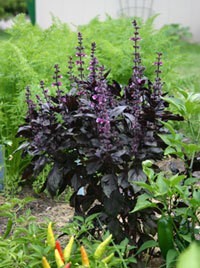
Nothing is better than harvesting homegrown fresh vegetables, but to really "spice" things up in the garden, consider setting aside a small corner for cultivating herbs.
Basil
It's tough to imagine growing tomatoes without Basil. The dark green and purple leaves of these plants are not only delicious; they make attractive borders along walkways and look great in pots.
Dill
If you plan to do any pickling, dill is a must. The stems and seeds are used for jar pickling and the leaves add wonderful flavor to salads and dishes featuring fish. Dill grows to a height of about 2 ft or more, and makes a delicate backdrop for flowers and shorter herbs.
Marjoram
This aromatic herb produces flavorful leaves that go great with leafy vegetables, as well as beans, peas and squash. It also works with almost any meat, fish or wild game and is often used as a salad-dressing additive. Its pinkish-purple flowers make a nice border or addition to flower beds.
Parsley
Parsley is the jack-of-all trades as far as herbs go. It can be used with every vegetable and a wide variety of meats. Parsley is really a biennial, but it does best if planted every year. There are three basic types: curled 'leaf (deep green leaves with a moss-like texture-often used for garnish), the Italian flat-leafed type and the Hamburg variety grown for its roots (boiled and served like parsnips in soups and stews).
Chives
These members of the onion family are a great addition to salads and vegetables and their ball-shaped flowers make a great landscaping border. There are many varieties of chives available including garlic and fine-leaf types.
Mint
Peppermint and Spearmint are the traditional varieties of mint in most gardens. Peppermint is great for flavoring jellies, teas and other drinks. Both will grow in a variety of soils and can spread very rapidly.
Oregano
Oregano is known as the pizza or Italian herb and makes a wonderful addition to salads, pastas, pork, squash and tomato dishes. It spreads well and prefers a light textured, well-drained soil in full sun.
Rosemary
This herb grows best outdoors in southern climates, but can be grown indoors in a sunny location in the cooler northern climates. Rosemary is especially good in squash dishes and with peas. Its green leaves and delicate blue flowers make nice border plantings.
Sage
Sage is usually thought of as the stuffing herb. Great in pork and poultry dishes, sage can grow as high as two feet and should be cut back to encourage growth. Use it as a leafy fragrant border along walkways. Space young plants 2-3 feet apart in the garden. Snip off tender tops of young plants or pick leaves for immediate use. Cuttings can be taken from well-established plants 2-3 times per season.
Thyme
Thyme comes in several varieties, offering scents including lemon and caraway. Creeping varieties are perfect for growing along garden pathways, steps or in containers on the patio. Plant them in a sunny location where soil contains a bit of grit, allowing about 20 inches between each plant.
When harvesting herbs, the appearance of blossoms determines the peak for harvesting. When blossoms start to open, take cuttings during the sunny morning hours when plant oils are at their peak. Rinse under cool water to remove any dirt or insects and pick off the damaged leaves. Once dried, small bunches hung upside down in your kitchen will give off a pleasing aroma and add charm to your décor.
To prepare herbs for long-term storage, choose a drying area that is dark, well ventilated and out of direct sunlight. Spread out cuttings on an old window screen, cheesecloth or other surface that allows for plenty of air circulation. Once the leaves appear crisp, strip them from the stems and place them in airtight containers to preserve their color. Store containers in a dark cupboard or pantry shelf until you're ready to use them.
The key to cooking with herbs is moderation. Once herbs are added to a dish, they cannot be taken out. Herbs should enhance the flavor of your dishes, not overpower them. Use the "add-taste-add-taste" method when determining how much of an herb should be added to dishes while cooking. Let your individual taste preferences be your guide.
The delicate flavor and aroma of herbs can be compromised if overcooked or over dried. If fresh herbs are used, chop them up or cut the leaves to release flavor. Dried herbs can be crumbled between your fingers as they are being added. If a recipe calls for dried herbs and you want to use herbs fresh from your garden, add twice as much as you would if they were dried.
The best time to add herbs while cooking depends on the length of cooking time. Ideally, herbs should be added to soups about ten minutes before the soup is removed from the stove. Add herbs to the pot right away when cooking with vegetables as they take less time to cook. For vinegar-based salad dressing, add herbs to vinegar and let stand at least 1 hour prior to mixing in oil.
If your recipe doesn't call for herbs but you feel like experimenting, use the following guidelines as a base to start from:

About The Author: Ellen Brown is our Green Living and Gardening Expert. Click here to ask Ellen a question! Ellen Brown is an environmental writer and photographer and the owner of Sustainable Media, an environmental media company that specializes in helping businesses and organizations promote eco-friendly products and services. Contact her on the web at http://www.sustainable-media.com
Add your voice! Click below to comment. ThriftyFun is powered by your wisdom!